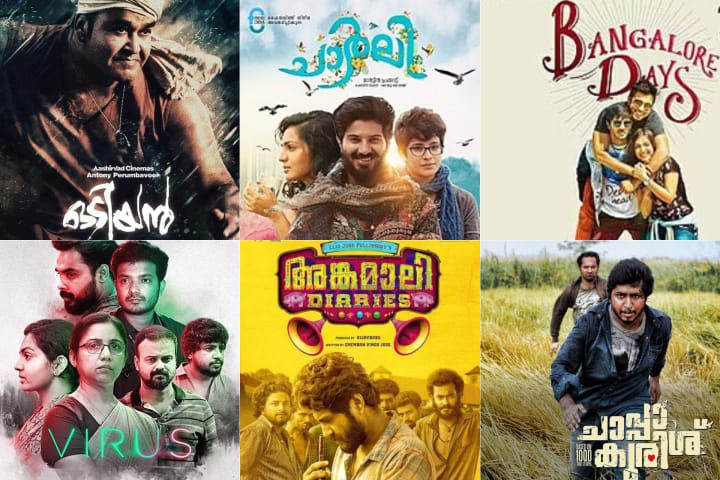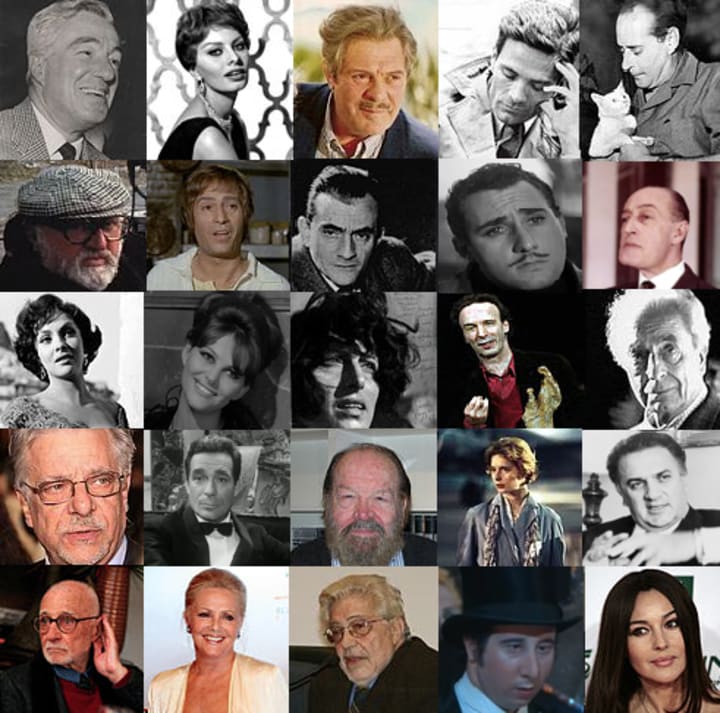Exploring the Top 20 Film Industries of the World
A Comparative Analysis

The film industry is a vast and constantly evolving landscape, with countless players and factors that contribute to its success. From Hollywood to Bollywood, the global film industry is a melting pot of creativity, talent, and innovation. In this article, we will delve into the top 20 film industries in the world, highlighting the unique characteristics and contributions that each one brings to the table. From the box office powerhouses of the United States and China, to the emerging film markets of Africa and Latin America, we will take a closer look at the trends and influences that shape the film industry today. Whether you're a film buff or simply curious about the inner workings of the film world, this article is sure to provide an enlightening and engaging read.
01.Hollywood (United States)

Hollywood is the center of the American film industry and is located in Los Angeles, California. It is known for producing some of the most iconic and successful films in the world, and is home to some of the biggest movie studios and production companies in the world.
The Hollywood film industry began in the early 1900s, with the first motion picture studio, the Nestor Company, opening in 1911. Over the next few decades, many more studios and production companies opened in Hollywood, and the industry began to grow rapidly.
The Hollywood film industry is known for its big-budget blockbusters, which often feature big-name actors, special effects, and high-quality production values. However, Hollywood also produces a wide range of other films, including independent films, documentaries, and foreign-language films.
One of the key features of the Hollywood film industry is the star system, which involves casting well-known actors in lead roles. This system began in the 1920s and has been an important aspect of Hollywood filmmaking ever since.
Hollywood movies are distributed and marketed globally, and are enjoyed by audiences all over the world. The industry also has a strong awards culture, with the Academy Awards, also known as the Oscars, being the most prestigious award in the film industry.
In recent years, the Hollywood film industry has faced challenges from streaming platforms such as Netflix and Amazon Prime, which have disrupted the traditional distribution and exhibition model of Hollywood films. However, Hollywood continues to be a major player in the global film industry, producing some of the most successful and critically acclaimed movies of all time.
02.Bollywood (India)

Bollywood, also known as Hindi cinema, is the Indian film industry based in Mumbai (formerly known as Bombay), Maharashtra, India. It is one of the largest and most prolific film industries in the world, producing over 1,500 films annually.
The term "Bollywood" is a portmanteau of Bombay (the former name of Mumbai) and Hollywood. The industry is known for its melodramatic and colorful films, often featuring elaborate song and dance numbers, as well as larger-than-life characters and storylines.
Bollywood films typically follow a formulaic structure, with a mix of romance, drama, action, and comedy. They often feature a love story, with a hero and heroine who must overcome obstacles to be together. The films also often include a family-oriented storyline and a message of social or moral importance.
Bollywood films are usually in the Hindi language, but many films are also made in other languages such as Bengali, Punjabi, and Tamil. They are widely popular in India and around the world, particularly in countries with large Indian diaspora populations.
The industry has produced many famous actors and actresses, including Amitabh Bachchan, Shah Rukh Khan, and Aishwarya Rai Bachchan. Many Bollywood films have also become international hits, such as "Slumdog Millionaire" and "Lagaan".
Bollywood has also been criticized for its portrayal of women and its lack of representation of marginalized communities. However, in recent years, there has been a push for more diverse and socially conscious storytelling in the industry.
Overall, Bollywood is a vibrant and unique aspect of Indian culture that has captured the hearts of people around the world with its colorful and emotional films.
03.Nollywood (Nigeria)

Nollywood is the nickname for the Nigerian film industry, which is the second-largest in the world in terms of the number of annual film productions. The industry began in the early 1990s and has since grown to include thousands of films produced every year.
Nollywood films are typically low-budget productions that are shot on video and are often released straight to DVD. They are known for their fast-paced storytelling and melodramatic plotlines, as well as their use of music, dance, and special effects.
Some of the most popular genres of Nollywood films include romantic comedies, action films, and dramas. Many of these films also incorporate elements of Nigerian culture, such as traditional music and dance, and often tackle social issues such as poverty, corruption, and gender inequality.
Nollywood films have a large and dedicated fan base in Nigeria and throughout Africa, as well as a growing international audience. Many Nollywood actors and actresses have become household names in Nigeria and have even achieved international fame, such as Genevieve Nnaji, Omotola Jalade-Ekeinde, and Ramsey Nouah.
Despite its success, the Nollywood film industry faces several challenges, such as a lack of funding and distribution networks, as well as piracy and copyright infringement. Nevertheless, the industry continues to grow and evolve, and it is expected to become a major player in the global film industry in the years to come.
04.Lollywood (Pakistan)

Lollywood, also known as Pakistan film industry, is the film industry based in Lahore, Pakistan. It is the second-largest film industry in South Asia, after Bollywood in India. The industry was established in Lahore in the 1940s, and it has produced thousands of films in Urdu, Punjabi, and other languages spoken in Pakistan.
The first Pakistani film, Teri Yaad, was released in 1948. The 1950s and 1960s were considered the golden age of Lollywood, with many popular films and actors, such as Waheed Murad, Nadeem Baig, and Sabiha Khanum. During this time, Lollywood produced a number of musicals, social dramas, and romantic comedies.
In the 1970s and 1980s, Lollywood faced competition from Bollywood and Hollywood, and the industry began to decline. However, in the 1990s, the Pakistani government began to provide support for the film industry, and Lollywood started to recover. Today, Lollywood is experiencing a resurgence, with a number of successful films and actors, such as Mahira Khan, Fawad Khan, and Ali Zafar.
Lollywood films are primarily produced in Urdu and Punjabi, but they also include films in other languages spoken in Pakistan, such as Pashto and Sindhi. The industry has also produced some English-language films.
The Lollywood film industry faces many challenges, such as a lack of funding, piracy, and a lack of distribution channels. However, the industry is making efforts to overcome these challenges and promote Pakistani films internationally.
Overall, Lollywood is an important part of Pakistani culture and entertainment, and it continues to produce a variety of films that appeal to a wide audience.
05.Tollywood (India)

Tollywood, also known as Telugu cinema, is the film industry based in the state of Andhra Pradesh, India. It is one of the largest film industries in India and produces films in the Telugu language. The term "Tollywood" is a combination of the words "Telugu" and "Hollywood."
The history of Tollywood dates back to the early 1900s when the first silent film, Bhisma Pratigna, was produced in 1911. The first talkie film, Bhakta Prahlada, was produced in 1931. Tollywood has since grown to become one of the most prominent film industries in India, with a large number of films produced every year.
Tollywood is known for its commercial cinema, with a focus on action, romance, and drama. The industry also produces a significant number of mythological and historical films. Tollywood films are known for their grandiose sets and elaborate song-and-dance sequences.
Some of the most popular actors in Tollywood include Chiranjeevi, Mahesh Babu, Pawan Kalyan, Jr. NTR, and Prabhas. These actors have a massive fan following and are known for their acting skills, good looks, and mass appeal.
Tollywood films are widely popular in Andhra Pradesh, Telangana, and other parts of India. Many Tollywood films are also dubbed in other languages and released in other parts of India and abroad.
Overall, Tollywood is an important part of Indian culture and a significant contributor to the Indian film industry. With a rich history and a diverse range of films, Tollywood continues to entertain and captivate audiences around the world.
06.Kollywood (India)

Kollywood, also known as the Tamil film industry, is one of the oldest and largest film industries in India. It is based in Chennai, Tamil Nadu and produces films in the Tamil language. The industry has a rich history dating back to the early 1900s and has produced many legendary actors and directors over the years.
Kollywood films are known for their unique storytelling, music, and dance. The industry has produced many critically acclaimed films that have won national and international awards. The films are also known for their strong social and political messages, which often reflect the concerns of the Tamil society.
The industry is home to many talented actors, directors, and technicians. Some of the most popular actors in Kollywood include Rajinikanth, Kamal Haasan, vijay, Smith and Sivaji Ganesan. The industry has also produced many talented actresses such as Jyothika, Trisha, and Anushka Shetty.
Kollywood films are widely popular in South India and also have a significant following in other parts of India and abroad. The industry releases around 200 films per year, with most of them being produced on a low budget. However, in recent years, the industry has seen a shift towards big-budget films with high production values.
The Kollywood film industry is also known for its vibrant music scene. Many of the films have memorable soundtracks that are popular among audiences. The industry has produced many legendary music directors such as A. R. Rahman, Ilaiyaraaja, and Harris Jayaraj.
Overall, Kollywood is a vibrant and dynamic film industry that has made a significant contribution to Indian cinema. Its films are known for their unique storytelling, music, and dance and continue to entertain audiences around the world.
07.Mollywood (India)

Mollywood, also known as the Malayalam film industry, is a regional film industry based in the state of Kerala, India. It produces films in the Malayalam language, which is spoken by the people of Kerala. The industry began in the 1930s with the production of silent films, and has since grown to become one of the most successful regional film industries in India.
Mollywood films are known for their strong storytelling and emphasis on social issues. Many of the films produced in this industry tackle themes such as poverty, corruption, and injustice. They also often feature strong performances from both male and female actors, with many of the leading actors and actresses becoming household names in Kerala.
The industry has also produced some of the most critically acclaimed films in India. Many Malayalam films have won national and international awards, including the National Film Award for Best Feature Film and the Kerala State Film Award for Best Film. Some of the most well-known films from Mollywood include "Chemmeen," "Perumthachan," and "Drishyam."
Mollywood has also produced some of the biggest stars in Indian cinema, including Mammootty, Mohanlal, and Suresh Gopi. These actors have not only appeared in many successful films in the industry, but have also gained popularity across the country and internationally.
In recent years, Mollywood has also seen an increase in the number of films being produced. This has led to a rise in the number of cinema halls and multiplexes in Kerala, making it easier for people to watch films. Additionally, the industry has also seen a rise in the number of digital platforms, such as Netflix and Amazon Prime, releasing Malayalam films, making them more accessible to a wider audience.
Overall, Mollywood is a thriving film industry that has a rich history and culture. It has produced some of the most acclaimed and successful films in India, and continues to produce films that are loved and appreciated by audiences around the world.
08.Sandalwood (India)

Sandalwood, also known as Kannada cinema, is the film industry of the Indian state of KarnATAKA. It is based in the city of Bengaluru, which is also known as the Silicon Valley of India.
The first Kannada film, "Sathi Sulochana," was released in 1934, and the industry has grown significantly since then. Today, Sandalwood is known for producing a wide range of films, including commercial blockbusters, arthouse films, and biopics.
Sandalwood has produced many critically acclaimed films that have won awards at national and international film festivals. Some notable films from the industry include "Gulabi Talkies," "Mungaru Male," "Kirik Party," and "KGF."
The industry is also known for its star power, with many popular actors and actresses such as Rajkumar, Vishnuvardhan, Ambareesh, Srinath, Anant Nag, and Puneeth Rajkumar.
Sandalwood is also home to many talented directors, such as Puttanna Kanagal, Girish Kasaravalli, and S. Shankar.
In recent years, the industry has seen a significant increase in the number of young filmmakers and new talent entering the industry. This has led to a renewed focus on the quality of films and the development of new technologies to improve the overall production process.
Overall, Sandalwood is a vibrant and dynamic film industry that is constantly evolving and growing. It has a rich history and a bright future, and it continues to be an important part of the Indian film industry.
09.Ghallywood (Ghana)

Ghallywood is the nickname for the Ghanaian film industry, which produces movies in the English, Twi, and Ga languages. The industry began in the early 1990s and has since grown to become one of the most prominent in Africa, alongside Nollywood (Nigeria) and Kannywood (Nigeria and Ghana).
Ghallywood films typically focus on social issues such as poverty, corruption, and family dynamics, and often have strong moral messages. They also often feature traditional Ghanaian music and dance.
Some of the most successful Ghallywood films include "The Perfect Picture," "Kumasi Yonko," and "The King is Mine." Popular Ghallywood actors include Jackie Appiah, Majid Michel, and Yvonne Nelson.
The Ghallywood film industry has faced challenges, such as piracy and a lack of funding, but it continues to thrive and gain recognition globally. In recent years, there has been an increase in collaborations with international film industries and festivals, including the Cannes Film Festival.
Overall, Ghallywood is an important part of the African film industry, showcasing the talents and stories of Ghanaians to a global audience.
10.Pollywood (India)

Pollywood, also known as Punjabi cinema, is the film industry of the Punjabi language spoken by people in the Punjab region of India and Pakistan. The industry is based primarily in the state of Punjab in India and the province of Punjab in Pakistan.
The first Punjabi film, "Chamkila", was released in 1930. However, it was not until the late 1970s and early 1980s that Pollywood truly began to take shape. The industry has since grown to become one of the largest regional film industries in India.
Pollywood films typically feature Punjabi culture and traditions, and are known for their high energy and vibrant music. The industry also produces a significant number of romantic and action films.
Some of the most popular Pollywood actors include Diljit Dosanjh, Gippy Grewal, Amrinder Gill, and Binnu Dhillon. Popular actresses include Neeru Bajwa, Sargun Mehta, and Sonam Bajwa.
Pollywood films are primarily produced in Punjabi, but some films are also produced in Hindi and English. The industry has also begun to produce international films, with Punjabi-language films being released in countries such as Canada, the United Kingdom, and the United States.
Pollywood has also seen a significant increase in the number of female directors and producers in recent years. This is a positive trend that has helped to diversify the stories and perspectives represented in Pollywood films.
Overall, Pollywood is a vibrant and growing film industry that showcases the rich culture and traditions of the Punjabi people.
11.Hallyuwood (South Korea)

Hallyuwood, also known as the Korean Wave, refers to the global popularity and influence of South Korean culture, particularly in the entertainment industry. The Hallyuwood film industry has seen a significant rise in recent years, with many South Korean films achieving international success and receiving critical acclaim.
The Hallyuwood film industry began to gain recognition in the early 2000s with the release of films such as "My Sassy Girl" and "Oldboy." These films were well-received by audiences both in South Korea and internationally, and helped to establish the industry as a major player in the global film market.
Since then, the Hallyuwood film industry has continued to grow, with many South Korean films winning awards at international film festivals and achieving box office success. Some notable examples include the films "The Host," "Mother," and "The Handmaiden."
The Hallyuwood film industry is known for its diverse range of genres, with films spanning across action, drama, horror, and comedy. South Korean films often deal with themes of family, love, and social issues, and are known for their strong storytelling and well-developed characters.
In addition to traditional films, Hallyuwood has also seen a rise in popularity of web dramas and webtoons, which are digital comics and dramas that are accessed online. These web dramas and webtoons are also gaining popularity globally and are often adapted into films and TV dramas.
The Hallyuwood film industry continues to gain recognition and popularity on a global scale, with many South Korean films and filmmakers gaining recognition and awards at international film festivals. The industry is expected to continue growing in the future, as more and more people around the world discover the unique and captivating stories of Hallyuwood films.
12.Collywood (Cambodia)

Collywood, also known as the Cambodian film industry, is a relatively small but growing film industry in Cambodia. The industry has a long history, dating back to the 1920s and 1930s when the first Cambodian films were produced. However, the industry was largely destroyed during the Khmer Rouge regime in the 1970s, and it took several decades for the industry to recover.
Today, the Cambodian film industry is experiencing a resurgence, with a growing number of films being produced each year. The industry is still relatively small, but it is gaining recognition both domestically and internationally. The Cambodian government has also been supportive of the industry, providing funding and tax incentives to filmmakers.
One of the most notable films to come out of the Cambodian film industry is "The Missing Picture" (2013), directed by Rithy Panh. The film was nominated for the Best Foreign Language Film at the 2014 Academy Awards. Other notable films include "Golden Slumbers" (2011) and "The Last Reel" (2014).
The Cambodian film industry is also home to a number of talented directors, including Rithy Panh, Dy Saveth, and Chhay Bora. These directors are known for their unique storytelling and their ability to tell stories that are both powerful and meaningful.
Overall, the Cambodian film industry is a vibrant and growing industry that is making a significant contribution to the cultural landscape of Cambodia. With the support of the government and the talent of its filmmakers, the industry is poised to continue growing and making a significant impact on the global film scene.Collywood, also known as the Cambodian film industry, is a relatively small but growing film industry in Cambodia. The industry has a long history, dating back to the 1920s and 1930s when the first Cambodian films were produced. However, the industry was largely destroyed during the Khmer Rouge regime in the 1970s, and it took several decades for the industry to recover.
Today, the Cambodian film industry is experiencing a resurgence, with a growing number of films being produced each year. The industry is still relatively small, but it is gaining recognition both domestically and internationally. The Cambodian government has also been supportive of the industry, providing funding and tax incentives to filmmakers.
One of the most notable films to come out of the Cambodian film industry is "The Missing Picture" (2013), directed by Rithy Panh. The film was nominated for the Best Foreign Language Film at the 2014 Academy Awards. Other notable films include "Golden Slumbers" (2011) and "The Last Reel" (2014).
The Cambodian film industry is also home to a number of talented directors, including Rithy Panh, Dy Saveth, and Chhay Bora. These directors are known for their unique storytelling and their ability to tell stories that are both powerful and meaningful.
Overall, the Cambodian film industry is a vibrant and growing industry that is making a significant contribution to the cultural landscape of Cambodia. With the support of the government and the talent of its filmmakers, the industry is poised to continue growing and making a significant impact on the global film scene.
13.Jollywood (Japan)

The film industry in Japan, often referred to as "Jollywood," has a long and rich history. Japan has produced a large number of films, many of which have gained international acclaim. The earliest known Japanese film was made in 1899, and by the 1920s, the country had a thriving film industry.
Japanese cinema is known for its wide range of genres, including action, horror, comedy, and drama. The country is also famous for its animation, and many Japanese animated films have been successful both domestically and internationally.
One of the most famous and influential directors in Japanese cinema is Akira Kurosawa, whose films such as "Seven Samurai" and "Rashomon" have had a major impact on the film industry worldwide. Other notable Japanese directors include Yasujirō Ozu, Kenji Mizoguchi, and Hayao Miyazaki.
Japanese films have often been recognized at international film festivals, with many winning awards at Cannes, Venice and other festivals.
The Japanese film industry has faced challenges in recent years, with a decline in box office revenue and a decrease in the number of movie theaters. However, it still remains a major player in the global film industry and continues to produce high-quality films.
14.Hong Kong film industry

The Hong Kong film industry, also known as the Hong Kong film industry, is a vibrant and influential film industry in East Asia. It is known for its unique blend of Chinese, Western, and Asian influences, as well as its action-packed martial arts films and crime dramas.
The Hong Kong film industry began in the 1920s, when the city was still a British colony. The first Hong Kong feature film, "The Difficult Couple," was released in 1913. However, it was not until the 1950s and 1960s that the Hong Kong film industry really began to take off.
In the 1970s and 1980s, Hong Kong cinema experienced a golden age, with the rise of martial arts films and action movies featuring stars such as Bruce Lee, Jackie Chan, and Jet Li. These films were hugely popular in Asia and around the world, and helped to establish Hong Kong as a major player in the international film industry.
In the 1990s and 2000s, Hong Kong cinema began to focus more on crime dramas and thrillers, such as the "Infernal Affairs" trilogy and "Election." These films were critically acclaimed and helped to establish Hong Kong as a center of cinematic excellence.
Today, the Hong Kong film industry continues to be a major force in the world of cinema, with a wide range of films being produced each year. Some of the most notable recent Hong Kong films include "The Grandmaster," "The Assassin," and "Ten Years."
Overall, the Hong Kong film industry is known for its unique blend of Chinese, Western, and Asian influences, as well as its action-packed martial arts films and crime dramas. It has played a major role in shaping the global film industry and continues to be a major force in the world of cinema.
15.Chinese film industry

The Chinese film industry, also known as the Chinese-language film industry, is one of the largest and most influential film industries in the world. It has a long history, dating back to the late 19th century, and is known for its diverse range of film genres, including martial arts films, historical dramas, and comedy films.
The Chinese film industry is based primarily in Beijing and Shanghai, but there are also many production companies and film studios based in other major cities such as Hong Kong and Taiwan. The Chinese film market is also one of the fastest-growing in the world, with an increasing number of Chinese films being released and distributed globally.
The Chinese government plays a significant role in the film industry, with the State Administration of Press, Publication, Radio, Film and Television (SAPPRFT) responsible for approving and regulating all films produced in the country. This has led to strict censorship laws, with certain themes and subjects being banned or heavily restricted.
Despite these restrictions, the Chinese film industry has produced many critically acclaimed and successful films in recent years, such as "Crouching Tiger, Hidden Dragon," "Hero," and "The Wandering Earth." Chinese filmmakers have also begun to make a significant impact on the global film industry, with Chinese directors and actors winning awards at prestigious international film festivals such as the Cannes Film Festival and the Berlin International Film Festival.
The Chinese film industry is also known for its strong partnership with Hollywood, with many American studios and production companies partnering with Chinese companies to co-produce and co-finance films. This has led to the release of many Hollywood films in China and the production of many Chinese-American co-produced films.
Overall, the Chinese film industry is a dynamic and influential player in the global film industry, known for its diverse range of film genres and its rapid growth in recent years. Despite the strict censorship laws and government regulations, Chinese filmmakers continue to push the boundaries and make a significant impact on the global film industry.
16.French film industry

The French film industry, also known as the French Cinema, is one of the oldest and most respected in the world. It has produced a wide range of films, from classic dramas to modern comedies, and has been a major influence on cinema around the globe.
France has a rich history of filmmaking, with the first French film, "The Arrival of a Train at La Ciotat Station," being produced in 1895. The French film industry began to flourish in the 1920s and 1930s, with the introduction of sound and the rise of the French New Wave movement. The French New Wave, led by directors such as François Truffaut, Jean-Luc Godard, and Agnès Varda, marked a new era in French cinema, characterized by a focus on personal expression and experimentation with new techniques.
Today, the French film industry continues to be a major player in the global film market, with French films winning numerous awards and accolades at international film festivals. French cinema is known for its diverse range of genres and styles, from the critically acclaimed dramas of Michael Haneke to the romantic comedies of Eric Toledano and Olivier Nakache.
The French government also plays an active role in supporting the film industry, through funding and tax incentives for filmmakers and the creation of organizations such as the National Center for Cinema and the Moving Image (CNC) and the French Film Commission.
Some notable French films and filmmakers include "La Grande Illusion" (1937) directed by Jean Renoir, "The 400 Blows" (1959) directed by François Truffaut, "La Haine" (1995) directed by Mathieu Kassovitz, "Amelie" (2001) directed by Jean-Pierre Jeunet, and "La Vie d'Adèle" (2013) directed by Abdellatif Kechiche.
Overall, the French film industry has had a significant impact on the world of cinema, with its unique style and storytelling, as well as its support and promotion of emerging talent in the industry.
17.British film industry

The British film industry is a vibrant and diverse part of the UK's creative economy. It is known for producing a wide range of films, from big-budget Hollywood blockbusters to independent and arthouse films.
The UK has a long and rich history in film, dating back to the late 19th century when the first British films were made. Over the years, British filmmakers have produced many notable films and have won numerous awards at international film festivals.
The British film industry is supported by a number of organizations, including the British Film Institute (BFI) and the UK Film Council. These organizations provide funding, support, and resources to help filmmakers create and produce their films.
One of the key strengths of the British film industry is its talent pool. The UK has a wealth of talented actors, directors, writers, and other film professionals. Many of these individuals have gone on to achieve international success and have helped to put British films on the map.
The British film industry is also known for its diversity. The UK has a rich cultural heritage and this is reflected in the films that are produced. There are a wide range of genres and styles of films produced in the UK, from historical dramas to comedy and science fiction.
The British film industry is also known for its strong special effects and post-production capabilities. Many of the world's biggest blockbuster films are filmed in the UK and take advantage of the country's world-class special effects and post-production facilities.
In recent years, the British film industry has faced challenges, including a decline in box office revenues and a decrease in government funding. However, the industry continues to evolve and adapt, and there are many exciting new projects and initiatives in development.
Overall, the British film industry is an important part of the UK's creative economy and continues to produce a wide range of high-quality films that are enjoyed by audiences around the world.
18.Italian film industry

The Italian film industry, also known as the Italian cinema, has a rich history dating back to the early 20th century. It is considered one of the most important film industries in the world, and has produced many acclaimed and award-winning films over the years.
One of the most notable periods in the history of Italian cinema is the period known as the "Golden Age," which lasted from the 1940s to the 1960s. During this time, many of the most important Italian filmmakers, including Federico Fellini, Roberto Rossellini, and Vittorio De Sica, emerged and created some of the most iconic films in Italian cinema. These films often dealt with social and political issues, and were known for their strong performances and emotional depth.
Another important period in the history of Italian cinema is the "New Wave," which emerged in the 1970s and 1980s. This period was characterized by a new generation of filmmakers who were interested in experimenting with new styles and techniques. These filmmakers, such as Michelangelo Antonioni and Bernardo Bertolucci, created films that were known for their complex storytelling and visual style.
Today, the Italian film industry is still going strong, and continues to produce a variety of films that are appreciated both in Italy and around the world. Some of the most notable contemporary Italian filmmakers include Paolo Sorrentino, Matteo Garrone, and Luca Guadagnino. These filmmakers are known for creating films that are both visually stunning and emotionally resonant.
Overall, the Italian film industry has a rich and diverse history, and continues to produce films that are enjoyed by audiences all over the world. Whether you are a fan of classic Italian cinema or contemporary Italian films, there is something for everyone to enjoy in the Italian film industry.
19.German film industry

Germany has a rich history in film, dating back to the early days of cinema in the late 19th century. The German film industry has produced some of the most influential and acclaimed films in the world, and has been a major contributor to the development of the medium.
In the early days of German cinema, the industry was dominated by the Expressionist movement, which produced a number of groundbreaking films such as "The Cabinet of Dr. Caligari" and "Nosferatu." These films were known for their bold visual style and dark, brooding themes.
In the 1920s and 1930s, the German film industry was one of the most productive in the world, producing dozens of films each year. However, with the rise of the Nazi regime, the industry was heavily censored and controlled by the government. Many Jewish filmmakers and actors were forced to flee the country, and the industry went into decline.
After World War II, the German film industry struggled to rebuild. However, in the 1960s and 1970s, a new generation of German filmmakers emerged, and the industry began to flourish once again. Some of the most notable films of this period include "The Tin Drum," "The Marriage of Maria Braun," and "Das Boot."
Today, the German film industry is thriving, with a number of talented directors, actors, and writers producing a wide variety of films. Some of the most successful and critically acclaimed German films of recent years include "Goodbye Lenin!," "The Lives of Others," and "Toni Erdmann."
In addition to feature films, Germany is also home to a thriving animation industry, producing a number of popular animated series and films such as "Wickie and the Treasure of the Gods" and "The Little Polar Bear."
Overall, the German film industry has a rich history and continues to produce a diverse range of films that are well-regarded both domestically and internationally.
20.Mexican film industry

The Mexican film industry, also known as the Mexican Cinema, is one of the oldest and most important film industries in Latin America. It has produced a wide range of films, from silent films to contemporary films, and has been a major influence on the development of the film industry in Latin America and around the world.
The history of the Mexican film industry can be traced back to the early 1900s, when the first silent films were produced in Mexico. These early films were often produced by foreign companies, but soon Mexican filmmakers began to create their own films. In the 1920s and 1930s, the Mexican film industry experienced a golden age, with many popular and critically acclaimed films being produced. This period is considered to be the golden age of the Mexican cinema.
During the 1950s and 1960s, the Mexican film industry experienced a decline, as the government began to heavily censor and control the content of films. However, in the 1970s and 1980s, the industry began to recover, with a new generation of filmmakers emerging. These filmmakers were known for their innovative and experimental films, which helped to revitalize the Mexican film industry.
Today, the Mexican film industry is considered to be one of the most important and vibrant film industries in Latin America. It continues to produce a wide range of films, from commercial films to independent films, and has a strong presence in international film festivals. The Mexican film industry is also known for its strong support of female filmmakers and its promotion of diversity and representation in its films.
Some of the most famous and acclaimed Mexican films and filmmakers include "El Ángel Exterminador" (The Exterminating Angel) by Luis Buñuel, "El Callejón de los Milagros" (The Alley of Miracles) by Jorge Fons, "Y Tu Mamá También" (And Your Mother Too) by Alfonso Cuarón, and "Roma" by Alfonso Cuarón.
Overall, the Mexican film industry has a rich history and continues to be an important and influential part of the global film industry.
About the Creator
Finola bozlar
〰️ Fiction (Horror/Thriller)
〰️ Non-Fiction (Nutrition and True Crime)






Comments
There are no comments for this story
Be the first to respond and start the conversation.